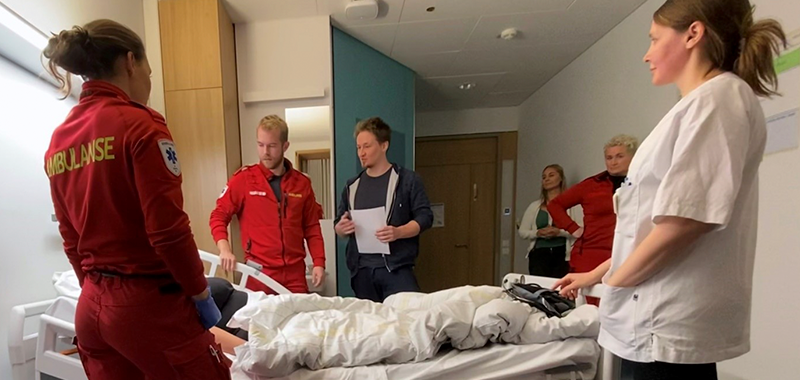
Paramedical students in their third year of study and nurses from the municipal health service participated in a joint training day simulating four clinical cases. The central learning objective was communication between several agencies in the emergency chain.
What is important to report when contacting 113? How do paramedics and nurses communicate together in primary care? How do paramedics communicate with Stavanger University Hospital? What do we need from each other so that we can ensure patient safety in the best possible way? These are some of the key questions that were used as a starting point for the joint training day at HelseCampus Stavanger, an innovation and co-creation arena for healthcare services, business, academia, patients, and relatives.
Heidi Synnøve Isberg is a professional advisor and project manager at the Development Center for Nursing Homes and Home Services (USHT) in Rogaland, Norway. She welcomed the participants and presented the communication tool ISBAR (Identify, Situation, Background, Assessment and Recommendation). It is a communication tool used in the health service to ensure safe and structured communication. ISBAR can be adapted for use between all levels and professions in the health service.
After the review, those present were divided into groups, to ensure an aneven distribution of nurses and paramedical students. Each group also had an instructor. Before each task, they discussed internally what are crucial elements in the work process. During the performance, second-year students in the bachelor’s degree in nursing at University of Stavanger (UiS) simulated patients. The participants alternated between the different roles: participant, phone operator and observer. After the implementation, the group had a debrief, where they discussed what could have been done better.
Satisfied with the learning outcome
“My impression of this day is very good. As paramedic students, we are used mostly as communication assistants for those who work as nurses. They can report to us. Our learning outcome is more about seeing how these nurses work and information sharing. Both parties agree about what kind of information should be shared when you meet at work,” says Ingrid Arnesen.
She believes it is very important to have nurses from the municipal health service at these exercises, as they often meet each other during work in real situations. One of the reasons for this is that nurses collect the necessary information for paramedics, who are going on an ambulance trip.
“I have gained a greater understanding of what happens before paramedics come in the door. Being able to stand and watch what is being done while we sit at the ambulance station and then get a call is very valuable,” says Arnesen.
Provides a better basis for handling real situations
Sander Eike Nygård is a nurse at Lura housing and activity centre. He also thinks that collaborating with paramedical students gives high learning outcomes.
“Everything we do here is to improve our own knowledge and make each other better across institutions. Both that we become good at conveying information to those who need it and that we get to know what information they want from us. We have good information dissemination and cooperation,” says Nygård.
Do you think this training day can make it easier the next time something actually happens in everyday work?
“Absolutely. It is difficult to familiarize yourself with a situation that is simulated compared to a real situation. However, it does make you reflect more on what you have done, how you could have handled it differently and how you could have communicated the information better. That makes simulation worth its weight in gold – that we can sit down and talk about what has happened. There won’t be much time for that in a real situation,” concludes Nygård.
Authors: Nina Vatland, Camilla Normand, Thor Ole Gulsrud, Une Stømer, and Peter Dieckmann, University of Stavanger



